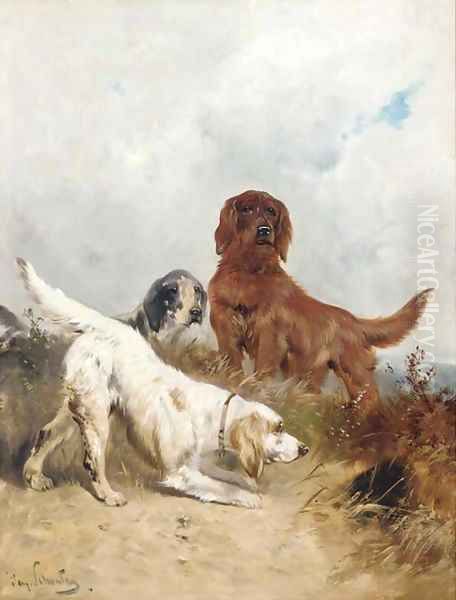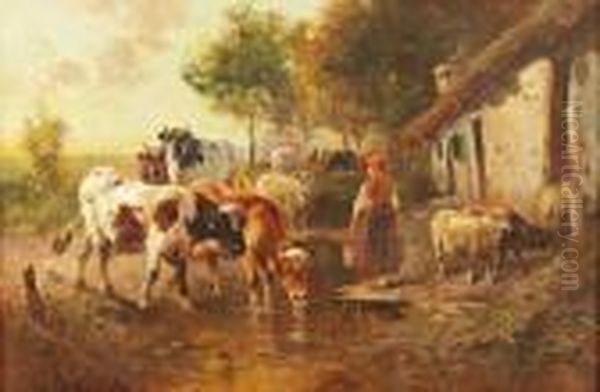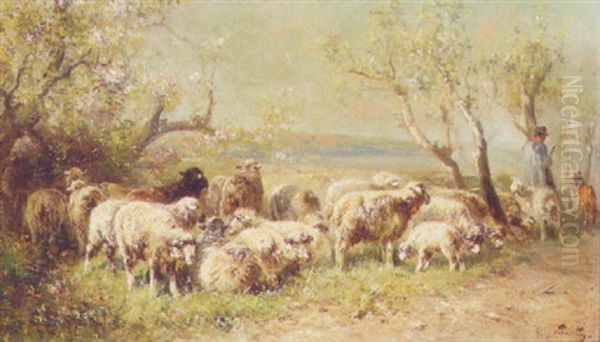Henry Schouten (1864–1927) was a notable Belgian painter primarily celebrated for his sensitive and detailed depictions of animals and rural scenes. Working predominantly in oil paint, Schouten captured the essence of pastoral life in Belgium during the late 19th and early 20th centuries. His work continues to be appreciated by collectors and art enthusiasts for its naturalism and charm.
Artistic Focus and Subject Matter
Schouten dedicated much of his artistic career to the portrayal of animals. His canvases frequently feature common inhabitants of the Belgian countryside, including poultry, cattle, sheep, horses, and dogs. He seemed particularly adept at capturing the textures of feathers and fur, as well as the characteristic postures and behaviours of these creatures. Farmyards, stable interiors, and open pastures often served as the backdrops for his animal subjects.
His paintings often convey a sense of tranquility and harmony associated with rural existence. Works like Mother and her brood , considered one of his representative pieces, exemplify his focus on domestic farm life and the interactions between animals. This focus places him within a long tradition of animal painting, or animalier art, which gained significant popularity across Europe during the 19th century.
Style and Technique
While the provided information doesn't explicitly assign Schouten to a specific art movement like Impressionism, his style is generally characterized by Realism. He demonstrated a keen observational skill, rendering his subjects with accuracy and attention to detail. The source material notes his sensitive handling of light, shadow, and colour, suggesting an ability to create convincing atmosphere and volume in his work.
His brushwork, typical for painters of this genre and period, likely balanced descriptive detail with a certain painterly quality. The overall effect is one of lifelike representation, aiming to capture the natural appearance and spirit of the animals and their environment without overt sentimentality, yet often achieving a gentle, approachable quality.
Notable Works
Several works are highlighted as representative of Henry Schouten's output:
Mother and her brood: Mentioned as a key work, this painting likely depicts a hen with her chicks, a classic theme showcasing Schouten's interest in farmyard life and animal behaviour.

On the scent: This oil painting, measuring 35½ x 26¾ inches (90.2 x 68 cm), bears the signature "Henry Schouten" in the lower right. Its title suggests a scene involving hunting dogs, a popular subject in animal painting. The fact that it has been listed as an auction item indicates its presence and recognition in the art market.
Retour à la bergerie (Return to the Sheepfold): This title points to a pastoral scene, likely featuring sheep being guided back to their enclosure, probably at dusk, allowing for studies of light. Its mention as having been exhibited underscores its significance.
Paysage à la troupeau (Landscape with Herd): Similar to Retour à la bergerie, this work emphasizes the integration of animals within a landscape setting. It too has been noted as an exhibited piece.
Portrait of a Brussels Griffon on a Cushion: Dated to around 1890, this oil on canvas measures 17 x 11 inches (43 x 28 cm). It showcases Schouten's skill in portraying specific breeds, in this case, a popular Belgian dog breed. Its exhibition history includes KSG Fine Art and showings in 1982 at the John Davies Gallery in Brussels and Morten-in-Marsh.
Brabant Draft Horses: Painted in the late 19th century, this work depicts the powerful draft horses native to the Brabant region of Belgium. These horses were vital to agriculture and transport, making them a fitting subject for a painter focused on rural life. The painting captures the strength and character of this specific breed.
Context within Belgian Art
Henry Schouten worked during a vibrant period in Belgian art history. The late 19th and early 20th centuries saw a flourishing of various artistic movements within the country. Realism had strong roots, with artists like Constantin Meunier gaining international fame for his powerful sculptures and paintings depicting miners and industrial labourers, offering a stark contrast to Schouten's rural focus. Alfred Stevens, though spending much time in Paris, was another Belgian Realist known for his elegant depictions of society women. Earlier figures like Henri de Braekeleer had established a reputation for intimate, detailed interior scenes. Charles Degroux was also a significant figure in Belgian Realism.
Alongside Realism, Impressionism and its variants made a significant impact. Emile Claus became the leading figure of Belgian Luminism, capturing the effects of light on the Flanders landscape in a style related to French Impressionism. Théo van Rysselberghe was a key proponent of Pointillism, applying Neo-Impressionist techniques to portraits and landscapes.

Symbolism also thrived in Belgium, producing highly individualistic artists. James Ensor, based in Ostend, created unique and often disturbing works filled with masks and skeletons, prefiguring Expressionism. Fernand Khnopff produced enigmatic paintings and drawings steeped in mystery and introspection. The moody, atmospheric works of Léon Spilliaert, often depicting solitary figures and coastal scenes, also belong to this Symbolist and proto-Expressionist vein. Figures associated with the Latem school, such as Gustave Van de Woestyne and Valerius De Saedeleer, also contributed significantly to Symbolist landscape and figure painting.
While Schouten specialized in animal painting, this genre itself had a strong tradition. In neighbouring France, artists like Rosa Bonheur achieved immense success with large-scale, realistic depictions of animals. Constant Troyon, associated with the Barbizon School, was also renowned for his landscapes with cattle. Within Belgium itself, Alfred Verwee was another contemporary known for his paintings of cattle and landscapes, operating in a similar Realist vein to Schouten. Schouten's work fits comfortably within this broader European context of realistic animal and landscape painting.
Exhibitions, Collections, and Market Presence
Specific information on major museum retrospectives for Henry Schouten is limited in the provided source material. However, it does confirm his work has been exhibited, citing showings of Portrait of a Brussels Griffon on a Cushion at KSG Fine Art and the John Davies Gallery in 1982. The mention of On the scent appearing at auction, and the general note that his works hold collection value, indicates an ongoing presence in the commercial art market.
His paintings are likely held in numerous private collections, particularly those focusing on Belgian art or the animalier genre. While major Belgian museums might hold examples, he is perhaps less represented than the leading figures of Impressionism or Symbolism mentioned earlier. His appeal often lies with collectors who appreciate well-executed, traditional depictions of animals and rural life.
Legacy
Henry Schouten's legacy rests on his consistent production of high-quality animal paintings and rural scenes. He catered to a taste for naturalistic representation that remained popular even amidst the rise of modern art movements. He documented a way of life and the animals central to it, providing charming and skillful depictions of the Belgian countryside.
While perhaps not an innovator on the scale of Ensor or Khnopff, Schouten was a master within his chosen niche. His ability to capture the likeness and character of various animals, combined with his competent handling of oil paint and composition, secured him a lasting place among Belgian artists of his generation who specialized in depicting the natural world. His works remain sought after by those who appreciate traditional animal painting and scenes of pastoral life.
Conclusion

Henry Schouten stands as a significant Belgian painter of the late 19th and early 20th centuries, renowned for his specialization in animal subjects and rural landscapes. Working primarily in a Realist style, he produced a considerable body of work characterized by careful observation, skilled execution, and an evident appreciation for the natural world. His paintings, featuring horses, cattle, poultry, and dogs within their typical environments, offer a window into the pastoral life of Belgium during his time. Though perhaps overshadowed by contemporaries associated with more avant-garde movements, Schouten's enduring popularity on the art market attests to his skill and the timeless appeal of his chosen subject matter.